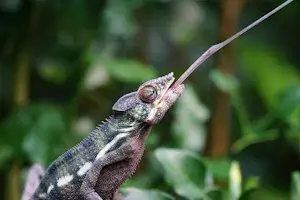EIntroduction: Panther Chameleons – Colorful Gems of Herpetology
The Panther Chameleon (Furcifer pardalis) is one of the most stunning reptiles kept in herpetology. With its vibrant color palette, fascinating movements, and characteristic independently rotating eyes, it is truly a sight to behold. However, keeping this unique creature requires experience, care, and knowledge. This article provides a complete guide to the proper care, maintenance, and feeding of Panther Chameleons.
1. Panther Chameleon: Origin and Lifestyle
Origin
The Panther Chameleon originates from Madagascar and nearby islands. It inhabits tropical forests and bushy areas, primarily living in trees and shrubs.
Lifestyle
- Diurnal: Panther Chameleons are active during the day, spending their time searching for food and defending their territory.
- Solitary: These territorial animals prefer solitary living.
Characteristics
- Size: Males can grow up to 50 cm, while females are smaller, reaching 30–35 cm.
- Color Variations: Their colors vary depending on the region and mood, ranging from green and blue to red and orange.
2. The Perfect Terrarium for Panther Chameleons
Terrarium Size
- Minimum Dimensions: 80 x 50 x 100 cm (L x W x H) for a single chameleon.
- Height is Key: As arboreal animals, chameleons require a tall enclosure.
Setup
- Climbing Branches and Plants:
Provide natural branches and twigs for climbing. Incorporate live plants like ficus, bromeliads, or schefflera to create a natural environment and boost humidity. - Substrate:
Use coconut husk or untreated potting soil to retain moisture. - Hiding Spots:
Dense plant areas offer privacy and reduce stress.
Lighting and Temperature
- UV Lighting: Essential for Vitamin D3 synthesis; use specialized UV lamps.
- Daylight Lamps: Provide bright light for 12–14 hours daily.
- Heat Spots: Create localized temperatures of 35–40°C under basking spots.
- Temperature Gradient: Maintain 24–28°C in the terrarium during the day, with a nighttime drop to 18–20°C.
Humidity
- Optimal Levels: 60–80%.
- Regular Spraying: Mist plants 2–3 times daily or use an automatic misting system.
3. Diet: What Do Panther Chameleons Eat?
Primary Diet
Panther Chameleons are insectivores. Suitable food includes:
- Crickets, locusts, roaches, and grasshoppers.
- Waxworms and superworms: Only occasionally, as they are high in fat.
Nutritional Enrichment
- Dusting: Coat insects with calcium and vitamin supplements before feeding.
- Gut Loading: Feed insects with nutritious food (fruits, vegetables) before offering them to the chameleon.
Feeding Schedule
- Juveniles: Feed daily.
- Adults: Feed every 2–3 days.
Water Consumption
Panther Chameleons drink water from leaves. Ensure hydration through regular misting or by providing drip systems.
4. Care and Health Maintenance
Terrarium Cleaning
- Daily: Remove feces and leftover food.
- Regularly: Clean the entire terrarium and replace the substrate every few months.
Recognizing Health Issues
- Warning Signs: Weight loss, lack of appetite, skin discoloration, or movement problems.
- Common Health Problems:
- Metabolic Bone Disease: Caused by calcium deficiency.
- Parasites: Such as mites or worms.
- Dehydration: Due to insufficient humidity.
Veterinary Care
Plan regular visits to a reptile veterinarian, especially if health issues arise.
5. Behavior and Interaction with Panther Chameleons
Observation Over Handling
Panther Chameleons are observation-only pets. Handling should be minimized as it causes stress.
Understanding Behaviors
- Color Changes: Used for communication or thermoregulation.
- Territorial Behavior: Males, in particular, may act aggressively toward other chameleons.
6. Breeding Panther Chameleons
Mating
Only healthy, sexually mature chameleons should breed. Males and females are kept together only during mating to avoid stress.
Egg Laying and Incubation
- Females lay 20–40 eggs in moist substrate.
- Eggs are incubated at 26–28°C.
Raising Hatchlings
- Hatchlings require separate enclosures with smaller climbing structures.
- Feed them small insects like fruit flies.
7. Legal Aspects and Costs
Conservation and Documentation
Panther Chameleons are protected under CITES. A certificate of origin is required when purchasing one.
Cost Overview
- Purchase: €100–400 per chameleon, depending on color and age.
- Terrarium and Equipment: €300–700.
- Ongoing Expenses: Food, electricity for lighting, and heating.
Conclusion: Responsible Care is Key to Wellbeing
Caring for Panther Chameleons demands time, knowledge, and commitment. With a well-equipped terrarium, proper nutrition, and regular maintenance, you can provide these fascinating creatures with a suitable home. In return, they will reward you with their stunning appearance and unique behaviors.

